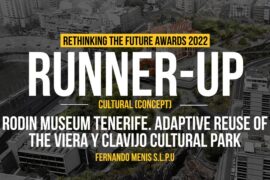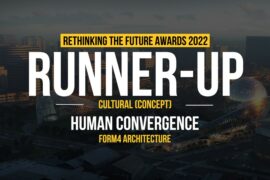As part of the winning team for an international design competition, New York-based architects Cooper Robertson have led the design of an expanded and renovated Gateway Arch Museum. Located at the base of Eero Saarinen’s iconic Arch in St. Louis, Missouri, within a National Park, the underground Museum explores seminal events in
American history, such as President Thomas Jefferson’s Louisiana Purchase, Lewis and Clark’s exploration of North America in 1804, and the role of St. Louis in the settlement of the American West. The Museum had suffered from a lack of visibility and was in need of a more relevant and contemporary narrative about the westward expansion of the United States.
Architects: Cooper Robertson
Status: Built

As a work of great monumental public art, Saarinen’s Arch is imbued with meaning, technological achievement, and beauty that must be compared with the most important American icons, like the Statue of Liberty. However, with the construction of the adjacent interstate highway, the setting of the Arch had diminished its potential to inspire ideas and emotions about relevant historic topics like migration and scientific exploration. The design of the new Museum and surrounding landscape has more fully realized that potential through an ambitious but respectful intervention that interprets the spirit of the Arch and amplifies its relevance to our time.

The new Museum occupies a renovated underground space built concurrently with the Arch with a 47,000 square foot expansion to the west, and a new entrance facing the Old Courthouse, site of the landmark 1857 trial of the slave Dred Scott. The majority of the interior of the existing space was demolished and reconfigured into
new galleries, public amenities, and museum staff offices. The original architectural elements of the existing public spaces were preserved, and their distinctive character highlighted with new lighting and other discrete interventions. The addition houses a new public lobby that also serves as a kind of visitor center for the entire Park, as well
as a great hall with monumental and animated elements that introduce the visitor to major themes to be explored in the galleries.

The Museum design is fully integrated into the National Register-listed landscape and respects Dan Kiley’s original Park design. The new circular stainless steel and glass entrance refers to the Arch in its materiality and form. It is an arc laid on to the landscape and precisely inserted into the topography, allowing visitors to enter the building through the landscape rather than descending underground. As one enters, the luminous great hall is revealed with views deep into the underground Museum’s monumentally scaled exhibits, elevating and enlivening the visitor experience, and drawing one in.

A giant map of North America floats below the entry hall. Visitors and school groups can land there and walk the path of Lewis and Clark, or follow the trails of pioneers migrating west. The map is also designed as a unique space for special events. Beneath the map is a new Education Center that supports the Park’s programs which previously had no dedicated space.
One moves down through the hall among screens projecting life sized videos of wagon trains journeying west across an open and rugged landscape with bison and other natural features of the frontier, creating a vivid experience of the migration before entering the galleries.

The linear exhibition offers various ways to navigate multiple stories on single and successive visits, and merges seamlessly with the trip up the Arch, and then delivers one at its base to experience the great work itself. The design creates a coherent and memorable visit by integrating the Museum content with the Arch.

The Museum is fully accessible for all ages and all abilities. The design is based on Universal Design Standards that exceed the legal requirements of the ADA and federalmandated ABAAS standards. This project demonstrates that excellent museum architecture, great monumental public art, and well-designed outdoor public spaces can make great cities. It is a key component of the larger plan to connect downtown St. Louis with the Park and the Mississippi Riverfront as the underground Museum expands towards downtown and opens onto a redesigned public square that now spans over a sunken interstate highway. The new Museum and Old Courthouse create an ensemble of buildings of national significance that define a transformed public open space in downtown St. Louis. Taken together with the Arch, this will become a new destination for those interested in architecture and history, contribute to the quality of urban life for residents, and drive economic revitalization.

This project is a result of the closely watched international competition, “Framing a Modern Masterpiece: The City + The Arch + The River”, which was organized by the non-profit Gateway Arch Park Foundation. The $96 million Museum is the cultural centerpiece of the overall $380 million comprehensive renewal of the Gateway Arch National Park.
- RTF 2025 Entries Open
- Register
- Jury
- 18th RTF Awards Results
- Previous
- Results | RTFA 2024
- Results | GADA 2024
- Results | GADA 2023
- Results | RTFA 2023
- Results | GADA 2022
- Results | RTFA 2022
- ACDA 2022 Results
- Results | GADA 2021
- Results | RTF Awards 2021
- Results | ACD Awards 2020
- Results | RTFA 2020
- Results | GADA 2019
- Results | ACDA 2018
- Results | GADA 2018
- RTFA 2017 Results
- RTFSA 2017 Results
- RTFSA 2016 Results
- RTFSA 2015 Results
- Results | RTFA 2015
- Results | RTFA 2014





